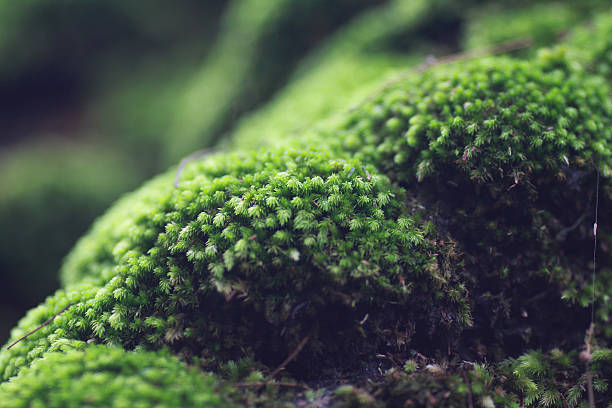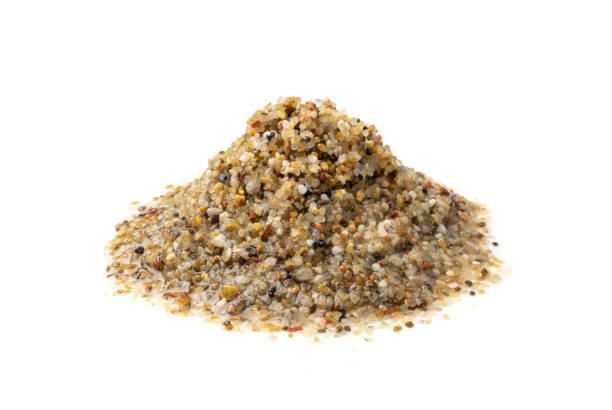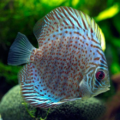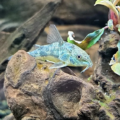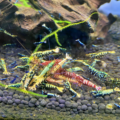Bright white or spotted? A complete overview on the many faces of the White Butterfly Discus, Including health care, feeding, compatibility, and breeding tips.

Are you looking for the perfect serene aquarium centerpiece for your fish tank? Then, you would love this elegant discus fish I’m about to introduce to you. It’s a pretty, pale discus fish with sometimes plain or patterned scales.
Hobbyists love the White Butterfly Discus for its peaceful nature, which makes it ideal for a harmonious community tank setup. If you’re ready to add this pretty and calm fish to your tank, then this White Butterfly Discus care overview is all you need.
No wasting of time; let’s get straight to business.
See also: Top 15 Stunning Discus Fish Types for Your Aquarium, to learn of even more Discus varieties.
The Unique Appearance of White Butterfly Discus

Of course the White Butterfly Discus’ appearance is its most striking feature, so let’s start our overview here.
Size
Like any other discus fish, the White Butterfly grows up to 6-8 inches wide and tall as adults. This graceful discus fish glides through water with its short fins, yet it catches your attention because of its color pattern.
Color Pattern

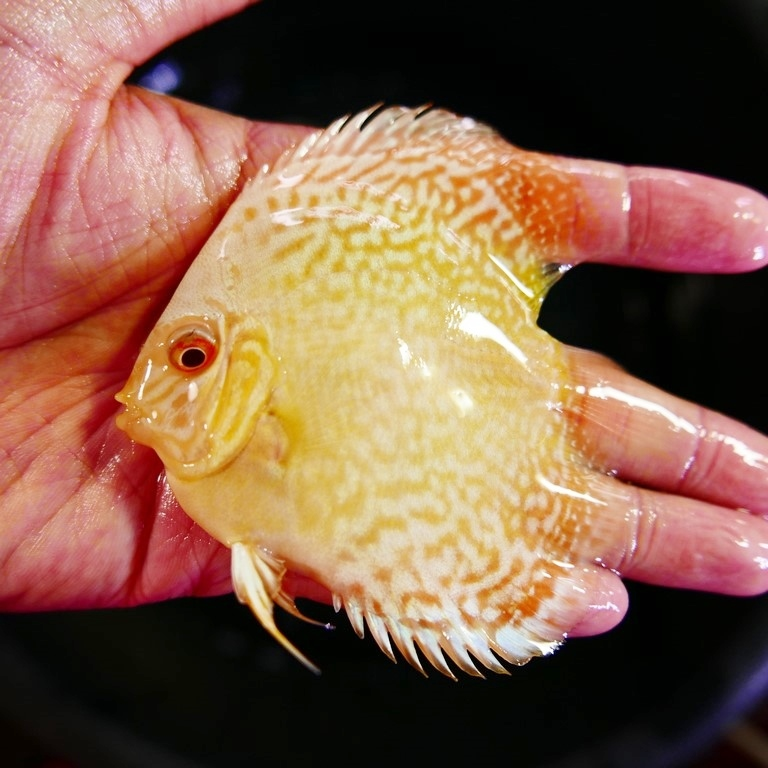
A typical White Butterfly Discus fish has pastel white scales, but its spotted patterns vary from bold yellow hue to red and sometimes orange shades on its fins and around its head. Some variants have bolder spots aligned like stripes, while others are sparse.
But there’s more reason to love this species.
Unique Traits
Besides the butterfly-like delicate wings and interesting patterned scales on this fish variant, there are other ways of identifying pale discus varieties.
They love schooling even though it’s in small groups of 4 to 6 fish. It may be with other White Butterfly Discus or a different species, but that’s what makes them loveable.
It’s time to prepare the ideal living environment for your new pets.
Crafting the Perfect Tank Setup
When designing your White Butterfly Discus tank, you must always reference its natural habitat. What facts do you know about this fish?
- They’re freshwater fish.
- They’re 6-8 inches in diameter.
- They move in schools of 5-6
So know that here’s how to craft the perfect White Butterfly Discus tank setup –
Tank Size and Layout
Get a 55-gallon rectangle tank to hold a school of six with one or more White Butterfly Discus. Then, fit in some low light to create a day-to-night cycle and ensure there’s enough space for your pets to move around.
Water Parameters
The ideal discus aquarium environment should have these parameters.
| Temperature | 82 – 86℉ |
| pH Level | Slightly Acidic at 6 – 7 on the scale |
| Hardness | Soft at 1 – 4 dKH |
Decor and Plants
Now, you should know that even though White Butterfly Discus are social, they love their space. When they get stressed, they need a safe hiding spot to re-energize.
That’s why you should use some of these aquascaping ideas for these pale discus fish’s tanks. They include pieces that can mimic their natural habitat:
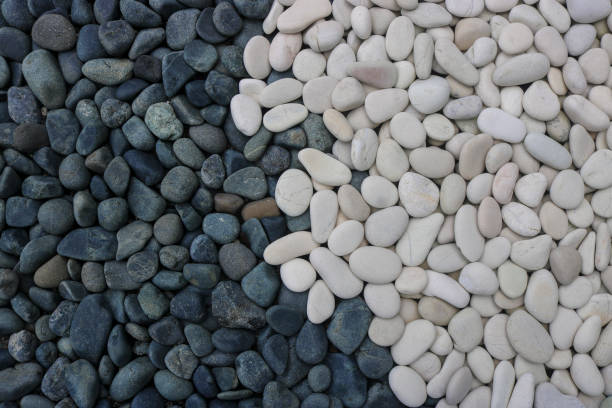
After properly housing your White Butterfly Discus, it’s time to feed your pets.
See Also: 17 Floating Aquarium Plants for Beginner Freshwater Aquarists
Dietary Recommendations for Healthy White Butterfly Discus
Feeding White Butterfly Discus is simple and budget-friendly because they eat both plants and animal matter. But there’s a catch; you must first understand why you’re feeding your pets. It’s not only for a healthy life but also enhancing discus colors through diet.
But don’t worry; I have enough Discus fish nutrition tips to help you have the healthiest and most beautiful White Butterfly Discus in your aquarium.
Food Suggestions
| Food Type | Suggestions | Benefits |
| Commercial | High-quality pellets, flakes high in carotenoids. | Staples for essential nutrients like protein and carbs |
| Live | Bloodworms | Sparks natural hunting instincts |
| Veggies | Blanched Spinach, Zucchini | Aids digestion and gut health |
For more on feeding your aquatic pets check out The Ultimate Guide to Fish Food: Pros and Cons & Best Choices!
Feeding Frequency
When crafting a balanced diet meal, ensure it’s only a portion your fish can consume in less than 3 minutes. Also, only feed adult White Butterfly Discus twice daily and the fry 3-4 times daily.
This feeding frequency reduces waste and potential water contamination from leftovers. Let’s talk a little more about breeding White Butterfly Discus before highlighting ways to ensure your pets stay in optimal health.
Breeding White Butterfly Discus: Challenges and Strategies

Breeding these pale discus fish can be a challenging experience when you’re a beginner. So, it’s good that you have this overview to tell you the DOs and DONTs of the process. I’ve summarized it in two simple headings – the breeding environment and fry care.
Breeding Environment
Your pet’s breeding environment wouldn’t be that much different from its normal living area, but there are some adjustments. Firstly, you must understand that White Butterfly Discus females spawn their eggs while the males fertilize them externally.
This video has been very helpful in identifying the sex of Discus fish, I highly recommend it:
When making the water parameters and tank ideal for your pets, you must also consider the new eggs they’re bringing to life.
Here are some White Butterfly Spawning tips to guide you:
- Tank Size: 20 gallons per pair
- Temperature: 82 – 86℉
- Hardness: 1-4 dGH
- pH level: 6-6.5
- Decor: Flat surfaces with spawning mops or large leaves
- Feeding: Protein-rich live foods like bloodworms and brine shrimp.
Within 2 – 3 days, your White Butterfly Discus eggs will hatch and feed on their parent’s mucus and yolk sac.
Caring for Fry
Within 7 – 10 days, the fry would start growing larger and need adjusted diets. Use this White Butterfly Discus fry care guide to ensure the young fish grows in good health.
- Include infusoria and liquid food in their diet
- Separate larger and stronger fry from the weaker ones
- Monitor the water parameters for stability
- Once fully grown, move the adult fish to the general community tank after a few days of quarantine.
Keeping a White Butterfly Discus is fun, right?
Choosing Compatible Tank Mates
| Yes | NO |
Corydoras Catfish Dwarf Cichlid Otocinclus Catfish | Barb Large Cichlid Aggressive Cichlid |
You can diversify your tank and pair this social pet with other fish or species.
Compatible Species
Look for other pets of similar sizes, environmental needs, and temperaments for the most compatible tank mates for White Butterfly Discus.
Add Tetras, Corydoras Catfish, Otocinclus Catfish, and Dwarf Cichlids as peaceful aquarium companions.
Incompatible Species
Generally say no to aggressive and larger species because they get territorial over food and can become predatory. So, Barbs and larger Cichlids aren’t compatible fish for serene tanks unless they live alone.
See Also: The 11 Best Large Freshwater Fish for Aquarium Keeping
Preventing Health Issues
I can’t leave without mentioning White Butterfly Discus health care now, can I? If you’ve followed all the guidelines to this point, then you’ve mastered disease prevention in discus fish. But you and I both know that’s not a guarantee of no illnesses. So, here’s how to identify health alarms and deal with them.
Preventative Care
- Maintain optimal water quality by changing 25 – 50% of the tank water weekly.
- Ensure stable water parameters
- Feed your pets a balanced diet
- Quarantine new fish for 2-4 weeks before adding them to the tank
- Observe your pets for behavioral and physical changes
Signs of Illness
| Signs | Illness | Cause | Treatment |
| – Hole-in-The-Head – Loss of Appetite – Laziness – Mucus in feces | Hexamita Disease | – Poor Diet – Poor Water Quality | – Medicated Food – Improved Water Quality |
| – Fraying, Decaying, Damaged Fins | Fin Rot | – Bacteria – Untreated Injuries | – Improved Water Quality – Anti-bacterial medication |
| – Gasping – Scratching – Clamped Gills | Gill Flukes | Flatworm Parasite | – Antiparasitic Meds (Prazinguantel) – Oxygenated Water |
| – White Spots – Rubbing – Rapid Gill Movements | Ich | – Temperature Fluctuations – Stress | – Increase temperature to the highest 86℉ |
For more details on Ich, checkout our article on How to Treat Ich Outbreaks in Your Freshwater Fish!
Remember observation and immediate reaction are vital to maintaining healthy aquarium fish.
Extending the Lifespan of White Butterfly Discus
A White Butterfly Discus can live up to 15 years when you take good care of the fish. But, maximizing discus fish longevity requires careful planning and meticulous care every day of your pet’s life.
First, I’ll show you the factors that affect this longevity, then share White Butterfly Discus lifespan tips for your pets to live at least 10 to 15 years.
Lifespan Factors
- Tank environment
- Water quality
- Diet
- Tank mates
- Disease prevention
Care Tips for Longevity
Focus on long-term care for your elegant discus fish because it’s an everyday journey.
- Stabilize water parameters and keep them optimal
- Pair with compatible tank mates
- Ensure tank size is spacious
- Use good aquascaping for comfort
- Feed them a high-quality diet
- Take illness prevention and treatment seriously
Conclusion: Achieving Success with White Butterfly Discus
Can you believe we’ve come to the end of the White Butterfly Discus care guide? Exactly! This process is as easy as learning the alphabet and is perfect for new and seasoned aquarists.
I’d love to hear and see how you use these beginner discus care tips. You can curate peaceful discus tanks with only one variant of this species or multiple variants mixed with other species. Whatever you choose, always ensure you’re putting your White Butterfly Discus health first.
Have Fun!


